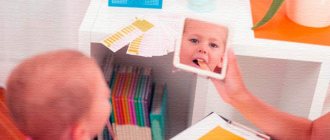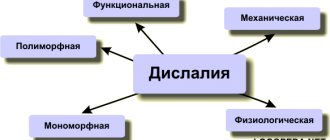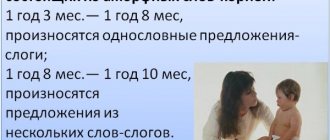Speech disorders in preschool children
Natalia Sosnovskikh
Speech disorders in preschool children
Speech disorders in preschool children
Speech
is a way of communication, without which integration in society is difficult. Parents eagerly await their baby's first words and want his speech to develop correctly and at the right time. That is why the question “at what age do children start talking?” becomes one of the most relevant in the first years of a baby’s life.
Speech, thinking and psyche develop simultaneously, and it is by the nature of speech or its absence that one can suspect deviations or delays in the child’s development.
All children go through certain stages in the development of speech: first the child gurgles, then babbles, speaks words and, finally, phrases. An important role in the passage of these periods is played by parents who talk to the baby, tell him about surrounding objects and phenomena, and encourage the baby to respond. But sometimes it happens that a child does not babble or babble a lot, and his first words and phrases appear late. Delayed speech development of the baby worries parents, and, trying to solve this problem, they turn to different specialists, usually pediatricians or neurologists. Doctors most often prescribe medication. Remember: in such situations, a speech therapist, a specialist in early childhood communication, can also provide effective assistance to the baby.
All parents, having learned from specialists that their child has problems with speech development, strive to understand what causes them. This question becomes especially important if none of the immediate family has speech disorders. They can arise under the influence of unfavorable circumstances, or, as experts say, external and internal harmful factors, often combined with each other.
Experts divide the reasons that cause speech disorders into two groups:
• Organic, which lead to damage to the central (brain areas responsible for the reproduction and understanding of speech) or peripheral (structures that control the articulatory organs) speech apparatus (organs necessary for speech reproduction);
• Functional, which interfere with the normal functioning of the speech apparatus.
The causes of speech impairment may be: INTRAuterine PATHOLOGY, HEREDITARY PRESPOSITION, GENETIC ANOMALIES, ADVERSE BIRTH AND THEIR CONSEQUENCES, DISEASES SUFFERED BY THE CHILD IN THE FIRST YEARS OF LIFE.
1. INTRAuterine PATHOLOGY
Intrauterine hypoxia
Infectious diseases of the mother during pregnancy (rubella, influenza, scarlet fever,
Working in hazardous industries
Violations of the terms of gestation
Alcohol and drugs.
2. HEREDITARY PRESPOSITION, GENETIC ANOMALIES
Features of the structure of the speech apparatus can be inherited, for example, incorrect fit and number of teeth, bite shape, predisposition to structural defects of the hard and soft palate
If one of the parents started speaking late, similar problems may arise in the child.
3. ADVERSE BIRTH AND ITS CONSEQUENCES
Birth injuries that cause intracranial hemorrhage can damage the speech areas of the brain.
Asphyxia is a lack of oxygen supply to the brain due to breathing problems, such as when the umbilical cord is entangled, which causes minimal damage to the brain.
Low birth weight of the newborn.
4. DISEASES SUFFERED BY A CHILD IN THE FIRST YEARS OF LIFE
Infectious viral diseases, neuroinfections (meningoencephalitis, meningitis) can cause decreased or loss of hearing.
Brain injuries and contusions.
Long-term colds, inflammatory diseases of the middle and inner ear, leading to temporary or permanent hearing loss, disrupt the child’s speech development.
Children who are often sick for a long time (somatic weakness) may begin to speak later than their peers.
Severe fear or stress, mental illness can cause stuttering, delayed speech development, mutism (the child stops talking to others due to mental trauma).
The emotional-volitional sphere often suffers: children are aware of their impairments, so they develop a negative attitude towards verbal communication, sometimes affective reactions to misunderstanding of verbal instructions or the inability to express their wishes, as well as:
• pronounced negativism (opposition to the requests and instructions of everyone around or specific individuals);
• aggressiveness, pugnacity, conflict;
• increased impressionability, often accompanied by obsessive fears;
• a feeling of depression, a state of discomfort, sometimes accompanied by neurotic vomiting, loss of appetite;
• enuresis (urinary incontinence);
• masturbation;
• increased sensitivity, vulnerability;
• tendency to morbid fantasies.
A comprehensive knowledge of the possible, and then a detailed identification of the existing psychological characteristics of pupils is necessary for a teacher-psychologist to determine the main directions of correctional and developmental work.
In children with general speech underdevelopment, general motor disorders may be observed (poor coordination of movements, motor clumsiness, underdevelopment of fine motor skills, decreased interest in play activities.
Slide 10:
The speech of a preschooler is not yet perfect, and the listed unfavorable factors can easily disrupt its development. At this age, there are several so-called critical periods of speech development: at 1-2 years, the speech zones of the brain intensively develop; at 3 years old the baby masters phrasal speech; at the age of 6-7 he enters school and masters written language.
Parents of children of different ages complain that “the child does not speak.”
The first words can appear between the ages of 9 months and 1 year 3 months, with boys slightly later than girls. Attention!
If at 2 years old the baby does not babble or utter AT LEAST a few words” and at 3 years old does not speak phrases, this is a serious cause for concern.
How can you tell if your baby has a speech delay?
The child understands well what adults tell him. Invite your baby to complete several tasks; they will help you find out how well he understands your speech. At 2 years old, the child understands simple instructions and tasks well:
Come into my arms.
Bring me a teddy bear.
Show a car (bunny, doll, etc.) in the picture.
Slide 11:
Some speech defects can be identified:
SRD (speech development delay) is a complex disease, the causes of which often remain unclear. Most often, it is determined before the age of four and represents a significant lag for a given age from the speech norm.
Slide 12:
Alalia is a condition in which the baby completely or largely lacks speech due to underdevelopment or pathologies of the areas of the brain responsible for the corresponding function, but the child hears well. There are sensory and motor alalia. With sensory alalia, the child is not able to understand someone else's speech: he recognizes sounds, but does not perceive the meaning of what is being said. Children suffering from motor alalia are not capable of learning and using language - they are unable to master sounds, syllables, and grammatical structures;
Slide 13:
Dysarthria is a general disorder of oral speech, namely: unclear, blurred pronunciation of sounds; a very quiet or unnaturally harsh voice; acceleration or deceleration of speech rate, lack of fluency; disturbance of breathing rhythm when talking. A characteristic feature of dysarthria is difficulty chewing. Children suffering from such a deviation refuse solid foods and are reluctant to eat meat. In an attempt to feed the child something, parents succumb to his whims and switch him to soft food, as a result of which the development of the articulatory apparatus slows down even more;
Slide 14:
Dyslalia is a problematic pronunciation of one or more consonant sounds: whistling, hissing, r, l. Manifests itself in the absence, distortion or replacement of sounds.
Slide 15:
Stuttering is a speech disorder accompanied by disruptions in the tempo and rhythm of pronunciation due to spasms or convulsions affecting various parts of the speech apparatus. A child who stutters has difficulty pronouncing words, is forced to take long pauses, and repeats syllables or sounds several times. Most often, stuttering develops between the ages of 2 and 5 years; During this period, it is recommended to pay special attention to the prevention of speech disorders in children.
Slide 16:
Correction of speech disorders in children requires an integrated approach, in which the use of psychostimulating and vasoactive medications is combined with psychotherapeutic and pedagogical methods of influence. In terms of typicality and persistence of external manifestations of speech disorders, alalia and dysarthria are in the first position; Various types of dyslalia and stuttering are somewhat less pronounced and easier to treat.
Slide 17:
If your child has speech problems, you should:
• Observe his behavior. Does the baby play with other children? Does he strive to communicate with peers and adults? Delayed speech development may be associated with communication disorders (autism) or mental disorders;
• Check how fully he understands the speech addressed to him, whether he copes with simple tasks that are not accompanied by gestures;
• Find out how well his hearing is developed;
• Conduct a thorough examination, including consultation with a speech therapist, neurologist and psychologist;
• If necessary, begin correctional therapy and speech therapy classes.
Slide 18:
Children with severe speech impairments do not have sufficient opportunity to enrich their lexical and intellectual potential through verbal communication. Therefore, the environment should become a source of development for them. Every child with one or another developmental disorder needs effective and rapid rehabilitation, allowing him to overcome developmental disorders. This is possible only if a single correctional and developmental space is formed around each such child, which is called upon to be supported not only by speech therapists and educators, but also, to varying degrees, by all the adults who surround him in everyday life and influence his development: speech therapist, teacher psychologist, medical staff, physical education director, music director, family and teacher.
Slide 19:
The teacher’s speech must comply with the rules of phonetics and grammar. He must have a fairly wide vocabulary. The teacher actively participates in the correction process, helping to eliminate speech defects and normalize the children’s psyche. In his work, he is guided by the general didactic principles of systematicity and consistency, and an individual approach.
The methods and techniques of the teacher’s work also change from stage to stage. Thus, at the initial stage, visual and practical methods and techniques come to the fore, as the most accessible to children with speech impairments. In kindergarten, the teacher solves general educational problems: forms in children the necessary, understandable amount of knowledge on a particular topic during observations on walks and excursions; promotes the development of children's speech by working to accumulate, enrich and activate the vocabulary, clarify the meanings of words and concepts; develops mathematical concepts in children, and also teaches children various techniques for depicting objects in drawing, modeling, applique, design, combining them with the development of speech. Along with this, a kindergarten teacher for children with speech underdevelopment solves correctional problems: forms positive skills in general and speech behavior, develops speech and consolidates the skills of using accessible active independent speech. The teacher teaches children to clearly express their requests, desires, and answer questions in a verbal form that is understandable to them. It improves children's communication skills with each other.
All correctional and educational work in a preschool institution is carried out both in special classes and in everyday life. The group's teachers - speech therapist and educator - must work in close collaboration and strive to create a unified approach to correctional and educational work. This is facilitated by:
— joint study of the content of the correctional program in a preschool institution and drawing up a joint work plan.
- joint preparation for all speech therapy classes and children's holidays (the speech therapist selects speech material, and the teacher consolidates it);
- general work with parents.
The joint work of the speech therapist and teacher with parents also determines the overall success of correctional education. Teachers are required to systematically meet with parents and inform them about successes and difficulties in working with their children. For this purpose, they jointly hold parent meetings, consultations, individual and group conversations, and set up special stands and mobile folders.
So, the successful implementation of correctional and educational work in a preschool institution for children with speech impairments presupposes the relationship in the work of the speech therapist and the teacher, and, what is extremely important, the correct distribution of responsibilities between them.
Causes of speech defects
There are quite a few of these factors. They can be either hereditary or acquired.
The causes of speech defects include:
- negative effects on the fetus during pregnancy and childbirth (for example, hypoxia - oxygen starvation);
- heredity;
- birth injuries to the head or brain damage in children under 3 years of age;
- structural features of the speech apparatus (for example, a short hyoid frenulum);
- lack of communication;
- mental trauma, tense family situation;
- an example of incorrect pronunciation on the part of adults.
Prevention of speech disorders. Helping a child at home
To prevent violations and for the general development of speech, constant communication is needed. Otherwise, problems will arise sooner or later, even if there were no medical prerequisites initially. A child learning a language must practice through regular contact with native speakers. And the carriers are you. Communication is an integral part of the education program.
What's useful:
- read together with your child, talk about what you read, illustrate the plot together, discuss the drawings;
- sing songs together;
- listen to the little why, without interrupting, answer his questions about the world around him, teach him to listen to others;
- correct errors in the pronunciation of words and sounds, find the correct analogues for “baby” words and “lisping” (“bobo”, “kaka”).
Mistakes that many people make, but I want to believe you don’t:
- the child’s questions are answered with the general “when you grow up, you’ll know” and “because it ends in U”;
- do little socializing and reading aloud; so that the child is not distracted from his work, they turn on cartoons for the whole day and leave him alone with the TV or computer;
- They repeat with tenderness after the baby everything that he babbles, thereby contributing to the reinforcement of incorrect words and illiterate pronunciation - they impoverish the speech of the future native speaker of the Russian language.
From a “technical” point of view, breathing exercises and tongue exercises are always beneficial. Breathing can be trained using play methods that are interesting to the child: blowing soap bubbles and balloons, learning to play toy flutes and harmonicas. There are standard articulation exercises for practicing various problem sounds, when the tongue, lips and teeth are held for 10-20 seconds in certain positions:
- sound “R” - mouth wide open, tongue at the upper jaw, tapping on the teeth while pronouncing the sound “D”;
- hissing - the lips are extended forward as much as possible, the jaws are closed;
- whistling - the end of the tongue rests against the front teeth of the lower jaw, and the edges against the far teeth of the upper jaw.
When we are talking not about prevention, but about the correction of already established deviations, the work is carried out more deeply, according to individual programs, with the regular participation of a speech therapist. If your child has clear signs of a speech disorder, but you cannot understand the reasons and what to do next, we suggest that you undergo a comprehensive diagnosis of speech disorders at our Center. To make an appointment for an examination and an appointment with a speech therapist, call tel. or use the online registration form on the website e.
When is it time to sound the alarm?
By the age of 1 year, the baby should be able to pronounce from 5 to 10 words. If he talks less or doesn't talk at all, that's a red flag.
At 2 years old, children already communicate in simple phrases, use verbs, and their vocabulary is about 200-300 words.
At 3 years old, a child actively uses common phrases - for example: “Masha (has) a Dasha doll.”
It is worth consulting with a speech therapist if the baby still speaks in monosyllabic sentences. You should also contact a specialist if your baby pronounces sounds incorrectly. Another cause for concern is the absence of verbs in speech, the pronoun “I” and the incorrect order and forms of words in sentences.
At the age of 4, children pronounce the sounds Z and S well. They already know how to talk about events that have happened, ask questions and express their thoughts out loud. The children also use words in their speech that denote temporal and spatial concepts (close, far, soon, etc.)
Five-year-old children can pronounce the hissing words Ш, Ж, Ш. They use all parts of speech in sentences and use generalizing words (car, plane is transport, etc.). The children are able to pronounce words without omissions or substitutions of syllables and sounds.
At the age of 6, a child should learn to pronounce the letter P and speak fairly long phrases without mistakes. Children 6-7 years old can correctly use sayings, set expressions, and also explain the meaning of words.
If you have the slightest doubt about speech development, you should contact a speech therapist. The sooner you start acting, the faster you can correct the defect.





